Even if you have had your UK driving licence for years, there are chances that you might be unfamiliar with the issue number on the driving licence or the driving licence category.
In the UK, a driving licence is an official document allowing you to drive on public roads.
In England, Scotland, and Wales, your driving licence is administered by the DVLA (Driver and Vehicle Licensing Agency), and in Northern Ireland by the DVA (Driver and Vehicle Agency).
According to the Road Traffic Act 1988 section 192, a driving licence is required to drive on highways or any other public road.
Having a driving licence in the UK requires you to know what the letters and numbers signify because they show essential information about you as a driver.
Instead of ignoring them and getting a hefty fine (in extreme situations), try to learn what they mean to have peace of mind when driving on the road.
In this article, we explain up-to-date information about your UK driving licence.
The article covers the following topics:
- Front of Driving Licence Explained
- Issue Number on Driving Licence
- Back of Driving Licence Explained
- Driving Licence Explained Codes
- Driving Licence Category
- How to Apply for a UK Driving Licence
- Do You Have to Carry Your Driving licence While Driving?
- Frequently Asked Questions
Contents
- 1 Front of Driving Licence Explained
- 2 Issue Number on Driving Licence
- 3 Back of Driving Licence Explained
- 4 Driving Licence Explained Codes
- 5 Driving Licence Category
- 6 How to Apply for a UK Driving Licence
- 7 Do You Have to Carry Your Driving licence While Driving?
- 8 Frequently Asked Questions
- 9 In Summary
Front of Driving Licence Explained
The front side of your UK driving licence will look similar to this one. Let’s explain it in detail:
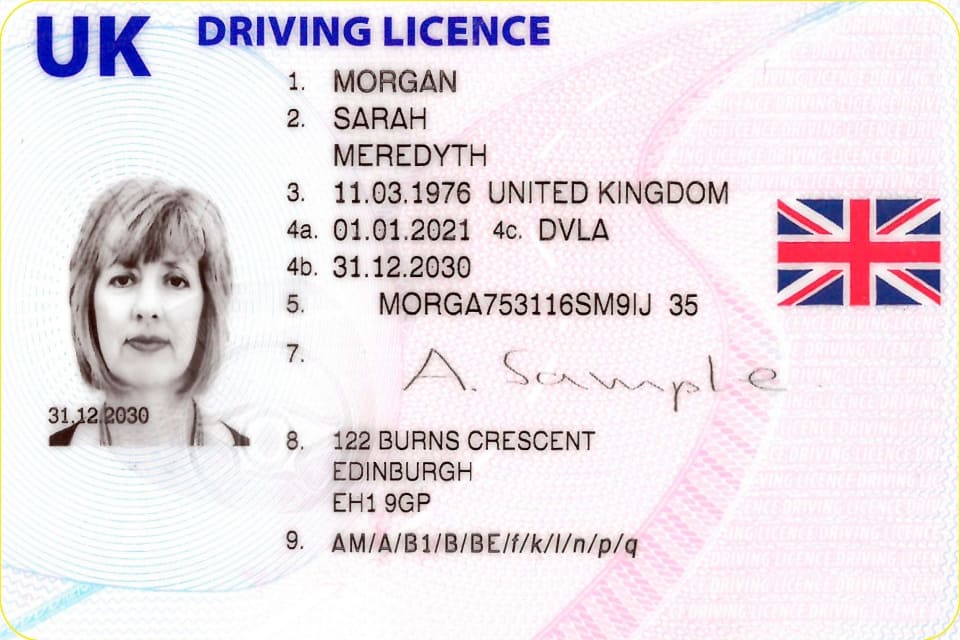
(Front of Driving Licence by gov.uk)
- Your Name: Numbers 1 and 2 of your driving licence displays your first and last name (middle name, if there is any).
- Date and Place of Birth: Number 3 shows your date of birth and then the country where you were born.
- Date of Driving licence Issue, Expiry, and Issuing Authority: Number 4a shows when the driving licence was issued. Number 4b displays the date when the driving licence will expire, and 4c shows the authority that issued the driving licence. As the issuing authority is DVLA, it is issued for a resident of England, Scotland, and Wales. If it’s DLA, the resident would be from Northern Ireland.
- Driving Number: Number 5 displays the driving licence number. Let’s break it down a bit so you can understand clearly:
- MORGA: The first five numbers of your driving licence number show your surname. You will see the digit 9 in the remaining spaces if your surname is less than five characters.
- 753116: In these digits, the first and last numbers are your birth year, while the second and third numbers are the month you were born. The fourth and fifth numbers are the day of birth.
- SM: These two characters are the first two initials of your surname. If your surname has one initial, the second character will be the digit 9.
- 9IJ: These three digits are randomly generated by the computer for security purposes.
- 35: Although these two digits are written in the same Number as the driving licence number, they are not a part of it. These two numbers represent your licence issue number, which will increase by one every time a new licence is issued.
- Picture: On the left of your driving licence number is your photograph, along with the expiry date of your driving licence.
- Signature: Number 7 shows the signature you provided during the driving licence application process.
- Permanent Address: Number 8 displays the licence holder’s permanent address. If you ever change your address, then you have to tell the issuing authority so they can update your permanent address and issue you a new driving licence. To include your house name, you have to contact your local authority.
- Vehicle Categories: Number 9 shows the categories of vehicles the user is allowed to drive.
Issue Number on Driving Licence
On the front side of your UK driving licence, you will find your issue number next to your driving licence number in number 5.
When you see it closely, you will notice that two digits are written separately at the end of number 5.
These two digits are the issue number on your driving licence.
They are not a part of your driving licence number and will increase every time you are issued a new driving licence.
Back of Driving Licence Explained
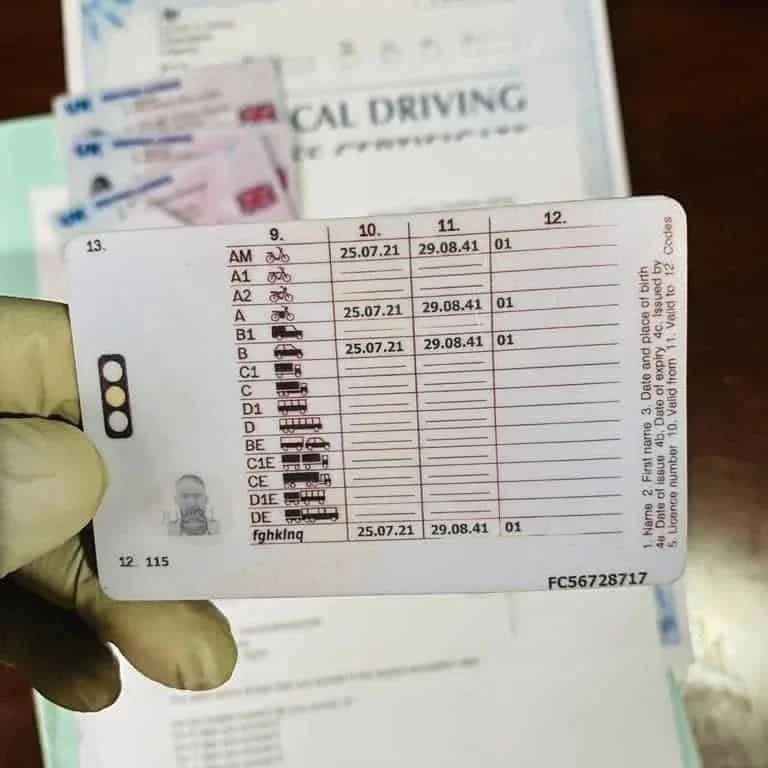
All the information related to your allowed vehicle categories is on the back side of your driving licence.
The back of the driving licence has four columns: columns 9, 10, 11, and 12.
- Vehicle Categories: Column 9 displays all the types of vehicles allowed on highways and public roads.
- Category Valid From Date: Column 10 shows the earliest date from which the category is valid. You can start driving the category from the date written in this column.
- Category Valid to Date: Column 11 shows the expiry date of the category. For instance, in the driving licence image above, you cannot drive a motorbike after 29 August 2041.
- Restriction Codes: Column 12 has all the driving licence codes that show what kinds of restrictions you have in the following vehicle category.
- Unique Card Identifier: You will see a code on the bottom right. This code is different for all driving licences and is used to identify a particular individual’s driving licence.
- Overflow of Information: On the bottom left part of the back of the driving licence, you will see the number 12. Number 12 is the overflow of information or restriction code.
Like the front side of your driving licence, you should know exactly what information is written on the reverse side.
Driving Licence Explained Codes
In the above section, we have explained the reverse side of the driving licence.
You might be confused about column 12 as only numbers are written in it.
These numbers hold certain restrictions for the vehicle you drive.
From health-related conditions to vehicle modifications, there are 52 driving licence codes that tell you what requirements you have to meet to drive on public roads.
The most common driving licence codes are as follows:
| Driving Codes | Descriptions |
| 01 | Eyesight correction -glasses or contact lenses are needed |
| 02 | A hearing or communication aid is needed |
| 15 | Your vehicle’s clutch is modified |
| 25 | Your vehicle’s accelerator system is modified |
| 43 | Your vehicle’s driving seats are modified |
44
|
Modifications to motorcycles
|
| 70 | Exchange of licence |
| 97 | You are not allowed to use C1 category vehicles, requiring a tachograph. |
| 105 | Not allowed to drive a vehicle more than 5.5 meters long |
| 106 | Automatic transmissions vehicles |
| 111 | 16 passengers limitation |
| 115 | Organ donor |
| 119 | Weight limit does not apply |
| 122 | Valid upon successful completion of basic moped training |
| 125 | Tricycle |
Remember: some codes may be different in Northern Ireland.
So if you live there, make sure to check out the information codes of that region.
Driving Licence Category
The driving licence category is displayed on the back side of your driving licence.
To drive a specific vehicle, you need to pass certain tests and get the entitlement for that category.
If you want to check your driving licence category online, learn how to check your driving licence online to see which vehicles you are allowed to drive.
You can also get other driving licence services, including replacing lost drivers licence and checking if your vehicle is taxed.
Let’s dive into all the driving licence categories in detail:
| Vehicle Type | Category | Minimum Age | Additional Test Required | Description |
| Mopeds | AM | 16 | Yes | This category allows licence holders to drive two to three-wheeled vehicles that have a design speed of over 25km/h (15.5mph), but no more than 45km/h (28mph). |
| Mopeds | P | 16 | No | This category allows you to drive only two-wheeled vehicles with speeds ranging from 28mph-31mph.
The engine size should not be above 50cc. |
| Mopeds | Q | 16 | No | In this category, you can drive two and three-wheeled vehicles that are without any pedals.
The maximum speed should be below 15.5mph, and the engine size should not be more than 50cc. |
| Motorcycles | A1 | 17 | Yes | A category is for motorbikes. The A1 category allows you to drive light motorbikes with an engine size of up to 125cc and a power to weight ratio below 0.1kW/kg. You can also drive electric tricycles with a power output of up to 15kW in this category. |
| Motorcycles | A2 | 19 | Yes | This category is a step up from A1. It allows you to drive a light motorbike with a power output below 35kW and a power to weight ratio of up to 0.2kW/kg. You can also drive regular motorbikes in this category |
| Motorcycles | A | 24 | Yes | In this category, you can drive any motorbike you want, with no restrictions. You can drive motorbikes with a power output above 35kW or a power to weight ratio above 0.2kW/kg.
You can also drive motor tricycles with over 15kW power output. You must be over 24, complete CBT (Compulsory Basic Training), and pass a practical and theory test. Or, just hold an A2 licence for two years and you will be eligible for the A category licence. |
| Light Vehicles and Quad Bikes | B1 | 17 | No | This category allows you to drive quad bikes (4 wheels) under 400kg. It can also be 550kg if it is for carrying goods. |
| Cars | B (if the test is passed before 1 January, 1997) | 17 | No | This category allows an individual to drive a vehicle with a trailer of up to 8,250kg MAM (maximum authorised mass). You can also drive a minibus attached to a trailer (over 750kg MAM). |
| Cars | B (if the test is passed on or after 1 January, 1997) | 17 | No | If you are above 21 years old, you can drive tricycles with a power above 15kW. For those under and above 21 years old, you can drive vehicles with eight passenger seats and a 3,500kg MAM (including a trailer).
You are also allowed to drive heavier trailers up to 3,500kg. |
| Cars | B auto | 17 | No | With this category, you are only allowed to drive an automatic vehicle. You can’t drive cars that are not automatic. |
| Cars | BE | 17 | No | This category means the driver can drive a vehicle with up to 3,500kg MAM (including a trailer).
The trailer size depends on the BE “valid from” displayed on your licence. If the valid from date is:
|
| Medium Vehicles | C1 | 18 | Yes | The licence holder is allowed to drive a vehicle ranging from 3,500kg to 7,500kg MAM (including a trailer up to 750kg). |
| Medium Vehicles | C1E | 18 | Yes | This category has all the benefits of C1, but you can take up to 12,000kg MAM combined on the roads. |
| Large Vehicles | C | 21 | Yes | You are allowed to drive vehicles of more than 3,500kg (including a trailer up to 750kg MAM). |
| Large Vehicles | CE | 21 | Yes | Similar to the C category, but it allows you to take a trailer of more than 750kg. |
| Minibuses | D1 | 21 | Yes | You can drive minibuses with up to 16 passenger seats, not more than 8 meters long, and a trailer under 750kg. |
| Minibuses | D1E | 21 | Yes | This category is an upgrade to the D1 licence as you are allowed to take a trailer above 750kg MAM. |
| Buses | D | 24 | Yes | You can drive any bus which has more than eight passenger seats. The trailer attached can be below 750kg MAM. |
| Buses | DE | 24 | Yes | This licence is for a bus driver who doesn’t want any limitations. You can take the trailer over 750kg. |
Some other driving licence categories include:
| Vehicle Type | Category | Minimum Age | Additional Driving Test Required |
| Agricultural Tractor | f | 17 | – |
| Roadroller | G | 21 | Yes |
| Tracked Vehicles | H | 21 | Yes |
| Mowers or Pedestrian Controlled Vehicle | k | 16 | – |
| Electrically Propelled Vehicle | l | – | – |
| Trolley Vehicles | M | – | – |
| Exempt from Duty | n | – | – |
Remember: According to the GOV.UK, you don’t need a driving licence to drive an electric bike, mobility scooter, or powered wheelchair.
How to Apply for a UK Driving Licence
Similar to applying for car insurance, you must apply for a driving licence for driving in London or other areas in the United Kingdom.
There are a few steps that you have to follow to apply for a UK driving licence:
- Visit GOV.UK in the DVLA section.
- Choose “Driving licences” and click on the “Apply for your first driving licence” option.
- Choose “Start Now” to start your driving licence application.
- If you are a new driver, click “Register” to read the terms and conditions and see the application form.
- After filling in all your details, log into your account and start the process.
However, there are a few things that you should know when applying for your first driving licence:
- It’ll cost you £34 to apply for a driving licence online. There are several payment methods available, including MasterCard and Visa for the payment.
- Keep your identity documents and the addresses where you have lived for the past three years in hand as you are going to need them.
- You may be asked to enter your National Insurance Number.
- After successfully applying for your driving licence, you will get a confirmation email from the DVLA (or DLA if you are from Northern Ireland), so make sure to check your email account when you are done.
- In normal cases, getting your driving licence will take around a week. The time can vary if the issuing authority wants to do additional checks.
Do You Have to Carry Your Driving licence While Driving?
As a driving licence in the UK is a necessary requirement by the government, you should carry it all the time when you are on the highways or public roads.
Whenever the law authorities stop you, you might be asked to show your:
- Car insurance
- Driving licence
- MOT certificate
You can face some consequences if you don’t have any of these documents.
They can give you a week to submit these documents to your nearest police station.
If you fail to submit the requested documents, you might face a hefty fine, a penalty, and even jail time in extreme cases.
Frequently Asked Questions
Is a UK driving licence powerful?
According to Business Insider, a UK driving licence is one of the most powerful driving licences in the world.
UK drivers can easily transfer their driving licences and drive nearly anywhere in the world.
Is UK driving licence test hard?
The United Kingdom has very tough theory tests. Unlike other countries like Japan and Brazil, the UK doesn’t require its residents to drive several hours before taking the actual practice tests.
In Summary
Hopefully, after reading our UK driving licence article, you will be able to understand what the issue number on driving licence is, what the codes mean, and what the categories mentioned on the back of your driving licence are.
By remembering all these, you will be able to know what you are allowed to drive and what restrictions you have on your driving licence.
Further Reading for Driving in the UK.
- Driving in London is one of the best options if you plan to have a road trip within London.
- Pay attention to the Congestion Charge when driving in London.
- Want to drive in the UK legally? You need a driving licence first. Follow these Steps to Get a Driving Licence in the UK.
- Before you decide to get a driving licence, you may want to know how much you are going to spend before applying for one. Check out our guide to how much for a driving licence.
- Choose one of the Best Driving Schools in London if you decide to learn to drive and get a full driving licence.
- You may want to know How Many Driving Lessons You Need to Pass the Driving Test.
- How much time should I spend on learning to drive? Read our guide to How Long Does It Take To Learn to Drive.
- Applying for the driving licence, but don’t know how to fill in the form? Download INF1D Booklet and read our guide to solve the problem.
- After applying for your driving licence, you may want to track your driving licence and know whether it is legal to drive if your Driving Licence Has Not Arrived.
- Want to check your driving licence online? Check out our guide to How To Check Status Of Driving Licence.
- If you are unlucky Losing your driving licence, it is not the world’s end, follow our detailed guide to Lost Driving licence UK | How To Replace And Apply.
- Can’t find out your Driving Licence Number? Don’t worry about it, here is a step-by-step guide to How to Get Driving Licence Number if Lost.
- Unfortunately, you get a Private Parking Ticket, but you don’t know how to deal with it. Should you pay for it? Check out our guide to Do You Have To Pay Private Parking Tickets.
- You may want to buy Car Insurance but don’t know how to buy it. Check out our guide to A Comprehensive Guide on Car Insurance in the UK.
- Can’t Remember your Car Insurance Company? Check out our guide to Who Am I Insured With.
- If you forgot your Car Insurance Expiry Date and want to find it out, here is our guide to 5 Ways To Check your Car Insurance Expiry Date.
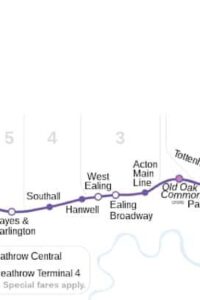
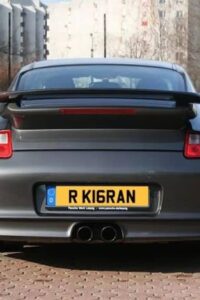
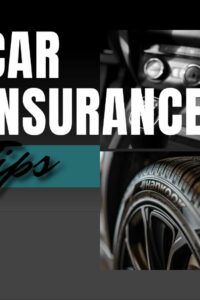
In my license in catogory B shows 70AE,78.Same in BE also. What it means.
Hello Bristan,
I think the codes 70AE and 78 in categories B and BE typically refer to specific driving entitlements or restrictions.
Here’s what each of these codes typically means:
70AE (Category B):
This code may indicate that you are allowed to drive a car with an automatic transmission only. In other words, you are not authorized to drive a car with a manual (standard) transmission.
If your license has the 70AE code, you can operate vehicles in category B (standard cars), but only if they are equipped with automatic transmissions.
78 (Category BE):
The code 78 in category BE typically refers to a driving entitlement for towing trailers or caravans. It allows you to drive a vehicle in category B (standard car) while towing a trailer or caravan with a maximum authorized mass (MAM) exceeding 750 kilograms, provided that the combined MAM of the vehicle and the trailer does not exceed 3,500 kilograms.
In essence, code 78 in category BE extends your driving privileges to include towing trailers or caravans within the specified weight limits.